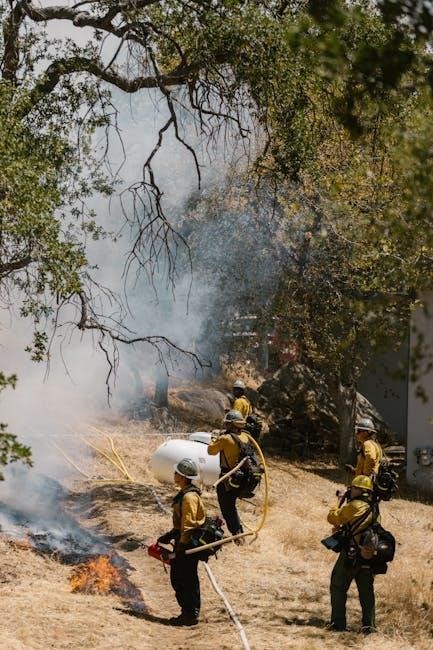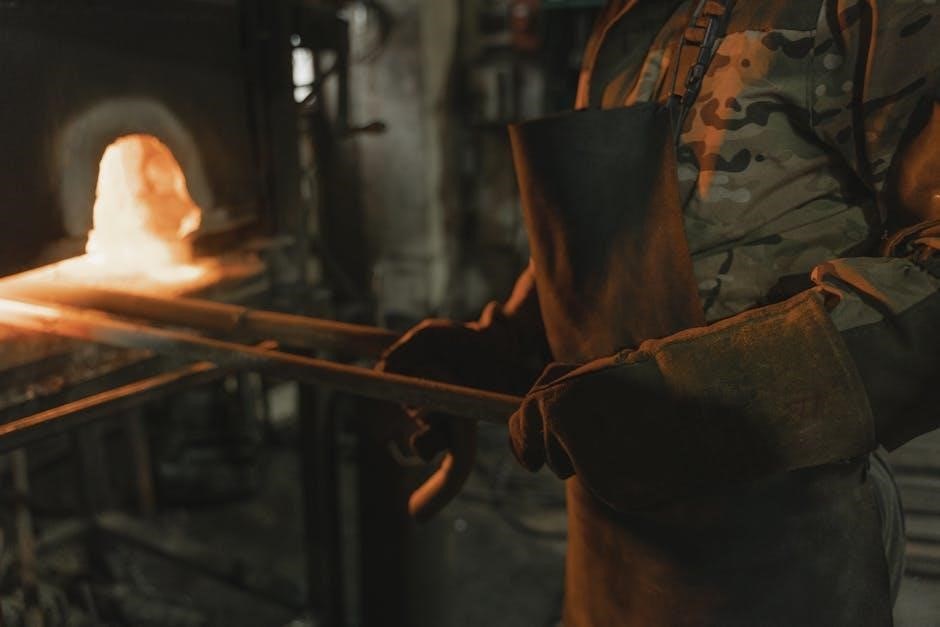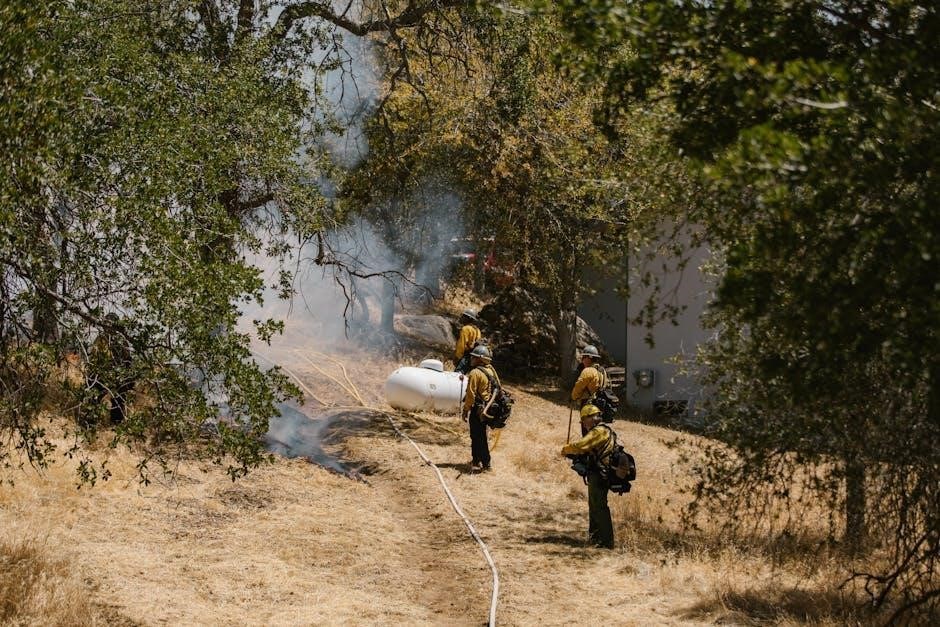The National Fire Protection Association publishes NFPA 921, a guide for fire and explosion investigations, providing standardized methodologies for both public and private sectors․ It is accessible online for free, with options to purchase print or PDF copies for detailed analysis and reference in legal and training contexts․
Overview of the National Fire Protection Association (NFPA)
The National Fire Protection Association (NFPA) is a nonprofit organization founded in 1896, dedicated to eliminating loss through knowledge and innovation․ As a global leader in fire, electrical, and related safety hazards, NFPA develops consensus-based codes and standards to protect people, property, and the environment․ Its work is supported by volunteers, members, and stakeholders worldwide, ensuring comprehensive safety guidelines are accessible to all․
NFPA’s mission emphasizes education, research, and advocacy to reduce fire risks and promote safety․ The organization is self-funded, relying on the sale of its standards and educational materials․ NFPA 921, its guide for fire and explosion investigations, is a cornerstone document for investigators, reflecting the organization’s commitment to scientific-based methodologies and public safety․
Importance of NFPA 921 in Fire and Explosion Investigations
NFPA 921 serves as the standard of care for fire and explosion investigations, providing a scientifically-based methodology to determine origin, cause, and responsibility․ It is widely recognized as the foremost guide for investigators, ensuring accuracy and reliability in their findings․ The document is referenced in training programs, court proceedings, and professional certifications, making it indispensable for both public and private sector investigators․ By adhering to NFPA 921, professionals can render informed opinions, contributing to justice, prevention, and public safety․
Purpose and Scope of NFPA 921
NFPA 921 provides a standardized methodology for investigating fires and explosions, ensuring scientific-based analysis․ It applies to both public and private sectors, establishing the standard of care for investigators․
Standardized Procedures for Fire Scene Investigations
NFPA 921 establishes comprehensive, science-based methodologies for fire and explosion investigations․ It outlines systematic approaches to ensure accuracy and reliability in determining incident origins and causes․ The guide emphasizes thorough documentation, evidence collection, and analysis, providing a framework for investigators to follow․ It includes detailed chapters on specific types of investigations, such as fires involving vehicles, electrical systems, and wildlands․ The 2024 edition incorporates updated research and best practices, reflecting advancements in forensic science․ By adhering to these standardized procedures, investigators ensure consistency and credibility in their findings, which are critical for legal proceedings and prevention strategies․ This framework is widely recognized as the benchmark for professional fire investigators worldwide․
Application in Public and Private Sectors
NFPA 921 is widely applied across both public and private sectors to ensure consistent and reliable fire and explosion investigations․ In the public sector, it serves as a critical resource for fire departments, law enforcement agencies, and forensic laboratories, guiding investigators to determine incident causes accurately․ In the private sector, insurance companies, legal professionals, and industrial organizations rely on it to assess liabilities and prevent future incidents․ The guide’s methodologies are integral to training programs and court proceedings, ensuring that investigations meet scientific and legal standards․ Its universal adoption fosters collaboration and trust between public and private entities, enhancing fire safety and accountability across industries․

Key Features of the NFPA 921 Guide
The NFPA 921 Guide provides scientific-based investigation methodologies, standardized procedures, and specific chapters for various fire and explosion investigation types, ensuring comprehensive and reliable analysis․
Scientific-Based Investigation and Analysis
NFPA 921 emphasizes the use of scientific principles to investigate fires and explosions, ensuring accurate and reliable conclusions․ It provides methodologies based on empirical evidence and established fire dynamics, helping investigators determine the origin, cause, and contributing factors of incidents․ The guide stresses the importance of systematic data collection, analysis, and documentation to support findings․ By adhering to these scientific standards, NFPA 921 helps professionals deliver objective, unbiased results that are defensible in legal and technical contexts․ This approach ensures consistency and credibility in fire and explosion investigations across various sectors․
Chapters on Specific Types of Investigations
NFPA 921 includes chapters dedicated to specific types of fire and explosion investigations, providing tailored guidance for unique scenarios․ These sections cover investigations involving vehicles, wildfires, and other specialized cases, offering detailed methodologies and considerations․ The guide’s comprehensive approach ensures investigators are equipped to handle a wide range of incidents effectively․ By addressing specific investigation types, NFPA 921 enhances the accuracy and thoroughness of fire and explosion analysis․ This structured approach supports professionals in applying standardized methods to diverse situations, ensuring consistency and reliability in their findings․ The specificity of these chapters makes NFPA 921 an indispensable resource for both general and specialized investigations․
Product-Specific Chapters for Fire Investigations
NFPA 921 incorporates product-specific chapters tailored to investigate fires involving particular devices or materials․ These chapters offer detailed insights into the unique characteristics of fires related to specific products, such as electrical appliances or flammable liquids․ By focusing on the behavior and failure modes of these products, investigators can identify ignition sources and contributing factors more accurately․ This section ensures that professionals are well-prepared to handle complex scenarios involving specialized products․ The guide’s product-specific approach enhances the depth and precision of fire investigations, making it a critical resource for determining causation and preventing future incidents․ These chapters are regularly updated to reflect advancements in technology and industry standards, ensuring relevance and effectiveness in modern investigations․

Editions of NFPA 921
NFPA 921 is regularly updated, with the 2024 edition being the latest․ It supersedes all previous versions, incorporating advancements in fire investigation science and technology․
History and Evolution of the Document
First published in 1992, NFPA 921 has undergone significant updates to reflect advancements in fire investigation techniques․ The guide has evolved to incorporate scientific methodologies, ensuring it remains a trusted resource for investigators․ Each edition builds on previous versions, addressing new technologies and investigative practices․ This evolution ensures the document stays relevant and maintains its status as a cornerstone in the field of fire and explosion investigations․
Latest Edition (2024) and Its Updates
The 2024 edition of NFPA 921 represents the latest advancements in fire and explosion investigation standards․ Released by the National Fire Protection Association, this edition incorporates updated methodologies, expanded chapters on specific types of investigations, and enhanced scientific-based analysis․ It reflects the evolving nature of fire investigation practices and technologies․ The 2024 version supersedes all previous editions and is widely recognized as the authoritative guide for both public and private sector investigators․ Its updates ensure alignment with current forensic standards, making it an indispensable resource for accurate and reliable investigations․

Accessing NFPA 921
The NFPA 921 guide is freely accessible online through the National Fire Protection Association website․ For offline use, PDF and print copies can be purchased from NFPA directly or authorized sources․
Free Online Access to the Guide
The NFPA 921 guide is available for free online through the National Fire Protection Association website, providing universal access to its methodologies and standards․ This free access facilitates widespread adoption and understanding among fire investigators, legal professionals, and the general public․ The online version is fully searchable, making it easier to navigate and reference specific sections․ While the guide is free to view online, users must purchase a copy for printing or downloading as a PDF․ This accessibility ensures that the guide remains a vital resource for training, legal proceedings, and field investigations, promoting consistency and scientific rigor in fire and explosion investigations worldwide․
Purchase Options for PDF and Print Copies
For offline access, NFPA 921 can be purchased in PDF or print format through authorized sellers like Intertek Inform and the NFPA store․ The PDF version allows digital access, while print copies provide a physical reference․ Purchasing ensures unrestricted use for legal, training, and investigative purposes․ Multi-user PDF licenses are available, requiring account creation for management․ Payments are secure, and copies are delivered promptly post-purchase․ Purchasing supports compliance with the latest investigative standards and ensures access to detailed methodologies and product-specific chapters․ Buying from authorized sources guarantees authenticity and adherence to the most recent updates, critical for professional and legal applications․ This option is ideal for those needing permanent, offline access to the guide’s comprehensive content․
Sources for Buying the NFPA 921 PDF
Authorized retailers like Intertek Inform and the official NFPA website offer the NFPA 921 PDF for purchase․ These platforms ensure authenticity and compliance with the latest standards․ Additionally, the ANSI Standards Store provides PDF copies, adhering to electronic format requirements․ Purchasing through these sources guarantees access to the most recent updates, including the 2024 edition․ Multi-user licenses are available for organizational use, requiring account registration․ Payments are securely processed, and PDFs are delivered immediately․ Buying from trusted sources ensures reliability and avoids unauthorized versions․ These retailers are recommended for professionals seeking accurate and up-to-date investigative guidelines, ensuring adherence to industry standards and best practices in fire and explosion investigations․

The Committee Behind NFPA 921
The Technical Committee on Fire Investigations develops and updates NFPA 921, ensuring it reflects current investigative practices․ The NFPA Standards Council oversees the process, maintaining its credibility and relevance․
Technical Committee on Fire Investigations
The Technical Committee on Fire Investigations is responsible for developing and updating NFPA 921․ Comprising experts in fire investigation, forensic science, and engineering, the committee ensures the guide reflects current methodologies and scientific advancements․ Their work involves reviewing research, industry practices, and feedback from stakeholders to refine the document․ The committee’s efforts aim to provide a comprehensive resource for investigators, addressing various aspects of fire and explosion analysis․ By maintaining a balanced representation of diverse expertise, the committee ensures NFPA 921 remains a trusted and authoritative standard in the field․
Role of the NFPA Standards Council
The NFPA Standards Council oversees the development and approval of NFPA 921, ensuring adherence to established procedures and maintaining its status as an American National Standard․ The council reviews recommendations from the Technical Committee on Fire Investigations, verifies consensus, and approves updates․ It also resolves disputes, monitors the standards development process, and ensures compliance with NFPA’s policies and procedures․ The council’s role is critical in maintaining the guide’s credibility and relevance, ensuring it reflects the latest scientific advancements and industry practices․ Through this oversight, the NFPA Standards Council guarantees that NFPA 921 remains a reliable resource for fire and explosion investigations․

Methodology and Concepts in NFPA 921
NFPA 921 provides a scientific-based methodology for fire and explosion investigations, emphasizing systematic approaches and key concepts like origin, cause, and responsibility determination, supported by empirical evidence․
Fire Investigation Methodology
NFPA 921 outlines a systematic, science-based approach for conducting fire and explosion investigations․ It emphasizes the importance of a thorough scene examination, evidence collection, and analysis to determine the origin, cause, and responsibility․ The methodology relies on empirical data and scientific principles to ensure accurate conclusions․ Key steps include identifying ignition sources, fuel, and oxygen dynamics, as well as considering human factors and mechanical failures․ The guide also addresses fire behavior, burn patterns, and the role of accelerants․ By following NFPA 921, investigators can ensure their findings are credible and defensible in legal proceedings․ This structured approach is widely adopted by professionals in the field, ensuring consistency and reliability in fire investigations․
Key Concepts and Definitions
NFPA 921 provides foundational concepts essential for fire and explosion investigations․ It defines terms like origin, cause, and responsibility, establishing a common language for investigators․ The guide distinguishes between accidental, incendiary, and undetermined fires, offering criteria for classification․ It also explains fire dynamics, combustion, and ignition sources, ensuring a scientific basis for analysis․ The document clarifies the role of accelerants and their detection methods, as well as the significance of burn patterns in determining fire spread․ These definitions and concepts are critical for conducting thorough, accurate investigations and ensuring consistency across the field․ By standardizing terminology, NFPA 921 supports clear communication and reliable outcomes in fire investigation processes․
Significance of NFPA 921 in the Field
NFPA 921 is a trusted resource in fire investigations, aiding experts in court proceedings and training․ It ensures accurate incident analysis, supporting prevention and legal decisions effectively․
Reference in Training and Certification
NFPA 921 is a cornerstone in fire investigator training and certification programs․ It provides detailed methodologies and scientific principles, ensuring investigators are well-prepared to conduct thorough and accurate analyses․ The guide is widely referenced in educational materials and professional courses, offering clear guidance on best practices․ Additionally, it serves as a foundational document for certifying fire investigators, emphasizing the importance of adherence to its standards․ By aligning training with NFPA 921, professionals gain the expertise needed to determine the origin, cause, and prevention of fires, making it an indispensable resource in the field․
Use in Court Proceedings
NFPA 921 is frequently referenced in court proceedings as a reliable standard for fire and explosion investigations․ Its scientific principles and methodologies are used to support expert testimony, ensuring accurate and unbiased conclusions․ The guide provides clear definitions and procedures, helping judges and jurors understand complex technical details․ By adhering to NFPA 921, investigators can render opinions on the origin, cause, responsibility, and prevention of fires with credibility․ This document is integral in legal cases involving fire incidents, as it establishes a consistent and defensible approach to investigation practices, ultimately contributing to fair and informed judicial outcomes while upholding public safety and justice․

Training and Certification Based on NFPA 921
NFPA 921 serves as the foundation for fire investigator training and certification, providing a comprehensive curriculum that ensures professionals meet standardized qualifications and methodologies in fire investigation practices․
Fire Investigator Curriculum
The NFPA 921 curriculum is designed to provide clear guidance for fire investigators, ensuring comprehensive coverage of essential topics․ It includes chapters on scientific-based investigations, fire dynamics, and scene analysis․ The curriculum emphasizes practical applications, such as determining fire origins and causes․ It also covers legal aspects, preparing investigators for court testimonies․ By adhering to NFPA 921 standards, professionals gain the knowledge needed to conduct thorough and accurate investigations․ This structured approach ensures consistency and professionalism in the field, making it a critical resource for both training and certification purposes․ The curriculum is regularly updated to reflect the latest advancements in fire investigation techniques and technologies․
Professional Qualifications for Fire Investigators
NFPA 921 establishes the foundation for professional qualifications in fire investigations, aligning with standards like NFPA 1033․ It emphasizes the necessity of knowledge in fire dynamics, scene analysis, and evidence handling․ Investigators must adhere to scientific methodologies and ethical practices to ensure accurate and reliable conclusions․ The guide underscores the importance of continuous education and training to maintain proficiency․ By following NFPA 921, professionals meet the industry’s expectations for competency, ensuring their investigations are thorough and defensible in legal proceedings․ This standard is a critical resource for both training and certification, fostering consistency and excellence in the field of fire investigation․
NFPA 921 remains a cornerstone for fire and explosion investigations, enhancing safety and accuracy․ Its scientific approach and standardized methods ensure reliable outcomes, shaping future investigative practices․
Impact of NFPA 921 on Fire Safety and Investigations
NFPA 921 has revolutionized fire safety by establishing scientific investigation standards, ensuring accuracy and reliability in determining fire causes and origins․ Its guidance is pivotal in training programs, court proceedings, and professional certifications, fostering expertise among investigators․ The document’s comprehensive approach, covering various investigation types, enhances public and private sector practices, improving fire safety outcomes․ By integrating the latest research, NFPA 921 remains indispensable for advancing investigative methodologies and reducing fire risks, ultimately safeguarding lives and property while supporting legal and educational frameworks globally․
Future of Fire Investigation Standards
The evolution of NFPA 921 highlights its adaptability to emerging technologies and methodologies in fire investigations․ Future editions are expected to integrate advanced tools like 3D scanning, artificial intelligence, and data analytics to enhance accuracy․ The document will likely address new fire hazards, such as those related to renewable energy systems and advanced materials․ Collaboration between experts and organizations will ensure that NFPA 921 remains a global benchmark, incorporating evidence-based practices to improve fire safety and investigative outcomes․ By continuously updating, it will support professionals in staying ahead of challenges, ensuring a safer future for communities worldwide․
